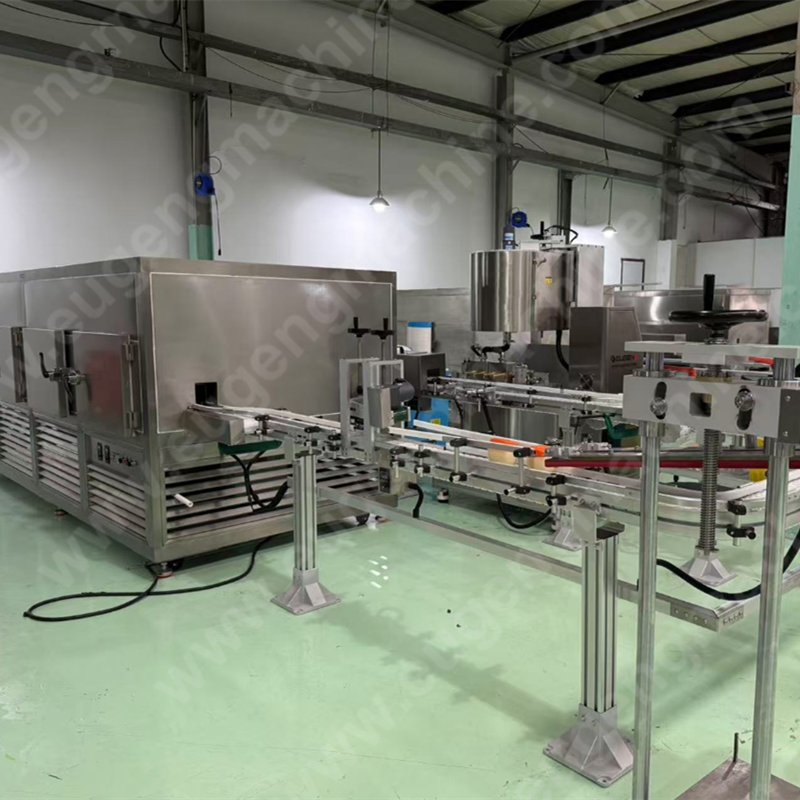Understanding Cosmetic Filling Machine Types
Pump Fillers for Liquids and Lotions
Pump fillers are also needed to accommodate light free-flowing liquids such as lotions and perfumes in the cosmetics industry. These fillers guarantee uniform and accurate filling with different pump versions (i.e. diaphragm pump or centrifugal pump), each one of them can be adjusted in flow rate according to the production demand. Pump material in particular should be given serious thought to prevent against chemical reactions with your cosmetic products--so your products remain safe and effective. Because it is important for cosmetic pump machine to ensure the integrity and cleanliness, the materials such as stainless steel should be used, and pump fillers are the ideal ones for liquid fillers in cosmetic industries.
Piston Fillers for Viscous Products
Piston Fillers are ideal for thicker products like creams and gels and offer accurate fill volumes while increasing production. This type of filler some features of the filling of the control is a piston mechanism to be very accurate of the fill will waste less and a more efficient use of resources. Stainless pistons Domestic and extradomestic industries choose stainless steel pistons for their resistance to wear and for long life of equipment and to guarantee max hygiene. Characteristics Piston Fillers are Champion's pillar in cosmetic filing technology, serving as an ideal choice for manufacturers concerned with accuracy and minimal operational downtime for the packaging of viscous products.
Gravity Fillers for Free-Flowing Solutions
Gravity fillers Gravity filling machines use the natural force of gravity to fill all kinds of containers, ranging from 1/2 oz. to 5-gallon containers.Gravity filling is suitable for thin, free-flowing products; it is not suitable for thick, viscous products, which do not flow well.Gravity fillers have a fill limit of 95%.A gravity filler is used for thin liquids and products if foaming is not a problem. Such a filler system is relatively low in maintenance and is generally appreciated as a relatively low cost solution for the small to medium volume production. Ease of operation is its contribution to less down-time and greater over-all efficiency in your plant. Gravity fillers, an integral element of a cosmetic filling machine, according to reports can considerably reduce downtime resulting in a more efficient process of handling free-flowing liquid cosmetics seamlessly in the cosmetics industry.
Key Considerations for Selecting Cosmetic Filling Equipment
Product Viscosity and Container Compatibility
Filling equipment and Viscosity Knowing your Cosmetic Product The viscosity of your cosmetic product is critical when determining filling equipment. Your product’s viscosity will determine if you need a pump filler, piston filler, or gravity filler — all of which are designed for different levels of thickness. Furthermore, compatibility with various types of containers including, for example, glass, plastic, or tubes, is a concern to the continued efficiency in production. Our advice is to actually try the various filling technologies on your product to optimize performance, production throughput and compatibility, because nobody can afford costly process downtime.
Production Volume and Speed Requirements
Production volume consideration is a key part of choosing the right filling machinery either manually, semi automatic, or completely automatic. For medium to high volume operations, full automation fills systems can process more than 100 bottles per minute to help increase production rates. These requirements inform the selection of the machines, which should not just meet the current production requirements, but should also have scalable functionalities to seamlessly adapt to the increasing production needs over time, while ensuring the company stays relevant in the fast-changing cosmetics business.
Automation Levels in Cosmetic Filling Machinery
Manual vs. Semi-Automatic Systems
Factors to consider when deciding between manual vs Semi-auto systems You will also need to consider the sort of operation and volume of business you’re involved in. When you are a small company or start-up in fact manual systems usually work out cheaper since they do not need high output. But they require more work which can create disparities in product filling and more labor costs over time. Semi-automatics on the other hand offer something of a compromise, better than the former while remaining somewhat affordable. These machines minimize labor and thus help to achieve a more uniform fill. It’s important to consistently measure this balance of labor costs vs. machine operational costs to determine the right approach for your business.
Benefits of Fully Automated Solutions
Automatic filling machines can increase productivity in the cosmetics industry by eliminating the need for human labor and limiting human errors. These are provided with modern features such as touch screen control, real-time monitor etc., for efficient results and accuracy. Fully automatic solutions This is the way to go if you’re seeking the maximum return on investment (ROI), as these machines run and run and keep on running and always deliver good quality. In addition, the accuracy and efficiency of automated alternatives can help to drive business growth by enabling scalable production runs in response to growing market needs.
Integration with Packaging Line Components
Capping and Labeling Synchronization
It is very important that the machine can operation with capping machine and labeling machine as a whole filling line. The less these machines clash with each other, the less congested the roads and the quicker work gets done. Machines working together, especially under high workload, can reduce delays and ensure market delivery without delay. Indeed, they do, because overall line efficiency can increase by as much as 30% in synchronized mode and this fact emphasizes the need for integration. Not only this but the productivity doubled with the increased quality and standard of the product, which is very important for the brand name.
Conveyor System Compatibility
Conveying system compatibility is critical to an efficient packaging process. Various systems, including belt, roller and overhead conveyors are greatest for certain production lines. Combine a cosmetic filling machine with conveyor machine system to streamline the process and get more product out within hours instead of days. This configuration reduces product handling mistakes and also the risk of damages to a minimum, so that the goods are received in perfect conditions by the end customer. It is then essential to consider choosing the right conveyor that will work well with the filling machine.(Low cost conveyor) This is because it plays an important roled in production efficiency and quality, and thus it becomes a critical element in the construction of a cosmetic filling line.
Future Trends in Cosmetic Filling Technology
Smart Automation and IoT Integration
The smart automation, and IoT integration in cosmetic filling technology promises a high prospect for the future. Together, these facilitate the real-time monitoring and dynamic control, which can greatly improve the operation of system. Equipment with data collection can anticipate when maintenance is needed, said industry experts, helping keep machines up and running. This evolution to connected products is not only making better products, but delivering higher levels of customer satisfaction. Smart automation means competitive advantage in cosmetic filling In the cosmetics filling market, smart automation can help companies ensure they are at the forefront of the competition.
Sustainability and Energy Efficiency
Sustainability and energy saving are leading the recent developments in cosmetic filling machines. Recent advancements are targeting lower energy use and less waste during bottle filling. Not only is this move towards sustainability cost saving â with possible 20% operational savings according to studies â but, it also taps into the increasing appetite for eco-friendly produce from consumers. In the pursuit of utilising energy smart machinery, not only do businesses serve to contribute to the wellbeing of the planet but they also place themselves ahead of their competitors by minimising their carbon footprint.
FAQ
What are the different types of cosmetic filling machines available?
The main types of cosmetic filling machines include pump fillers, piston fillers, and gravity fillers. Pump fillers are suited for free-flowing liquids like lotions, piston fillers work well with viscous products like creams, and gravity fillers are ideal for non-viscous liquids.
How do I choose the right filling machine for my cosmetic product?
Choosing the right filling machine depends on the viscosity of your product and your production needs. Consider factors such as the type of liquid, container compatibility, production volume, and speed requirements when selecting a machine.
What are the benefits of using automated filling machines?
Automated filling machines increase productivity by reducing labor costs and minimizing errors. They feature advanced controls and real-time monitoring, which improve operational efficiency and maintain consistent quality standards.
How does IoT integration benefit cosmetic filling machines?
IoT integration in cosmetic filling machines enables real-time tracking and adjustments, enhancing efficiency. These machines can predict maintenance needs, reducing downtime and improving overall product quality.

 EN
EN
 AR
AR BG
BG HR
HR CS
CS DA
DA NL
NL FI
FI FR
FR DE
DE EL
EL HI
HI IT
IT JA
JA KO
KO NO
NO PL
PL PT
PT RO
RO RU
RU ES
ES SV
SV TL
TL IW
IW ID
ID LV
LV LT
LT SR
SR UK
UK VI
VI HU
HU TH
TH TR
TR FA
FA MS
MS UR
UR BN
BN LO
LO LA
LA PA
PA
